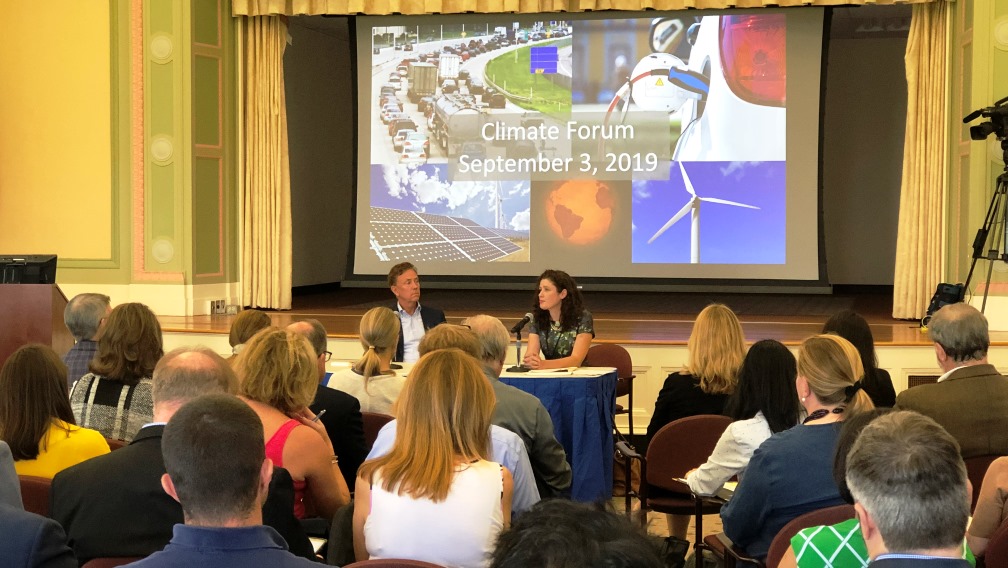On September 3, 2019, Connecticut Governor Ned Lamont announced that he had signed an executive order strengthening Connecticut’s ongoing efforts to combat the effects of climate change and ensure that the state’s communities are as resilient as possible to rising sea levels and increasingly powerful storms.
The governor signed the order surrounded by environmental advocates, clean energy leaders, state officials, and legislators, who were joining him at a forum he co-hosted with Department of Energy and Environmental Protection (DEEP) Commissioner Katie Dykes in Hartford to receive input and discuss issues related to climate change, specifically as their administration prepares its package of legislative proposals for the 2020 session of the General Assembly, which begins in February.
“Climate change is an urgent, existential threat that must be tackled immediately, and under the leadership of this administration I am going to see to it that Connecticut remains a national leader on climate action,” Lamont said.
“While the highest levels of our federal government are refusing to accept scientific facts, we need state governments to unite and address one of the most pressing international problem of our times. The effects of climate change are impacting our air, water, health, natural resources, economic, and the quality of life of every current and future citizen of Connecticut. We have an obligation to act now,” he added.
Governor Lamont’s Executive Order No. 3 directs the following:
- Expands the responsibilities of the Governor’s Council on Climate Change (GC3):
- Created in 2015 by Governor Dannel P. Malloy’s Executive Order No. 46, the Governor’s Council on Climate Change (GC3) has been meeting for the last several years to develop strategies that will ensure the state meets its mandatory greenhouse gas reduction targets created by the 2008 Global Warming Solutions Act and the 2018 Act Concerning Climate Change Planning and Resiliency, both of which were adopted by the Connecticut General Assembly and signed into law. The council’s strategies were presented in a report that was delivered to state leaders in December 2018. (“Building a Low Carbon Future for Connecticut: Achieving a 45% GHG Reduction by 2030”)
- To see that the recommended strategies from the GC3’s December 2018 report are being implemented, Governor Lamont’s Executive Order No. 3 expands the responsibilities of the council and requires it to monitor ongoing progress in the execution of the strategies. The council will be required to provide the governor with a report on these implementation efforts by January 15, 2021 and annually thereafter.
- In addition, the council’s scope has been expanded and – working in consultation with every state agency – it will be required to develop a climate adaptation strategy that assesses and prepares the state for the impacts of climate change in areas such as infrastructure, agriculture, natural resources, and public health. This includes conducting an inventory of vulnerable assets and operations and incorporating resilience into state operations and investments. It will be required to present the governor with a revised statewide Adaptation and Resilience Plan for Connecticut by January 15, 2021.
- Increases membership of the GC3:
- To ensure a diversity of voices are represented on the GC3, Governor Lamont’s Executive Order No. 3 adds several seats to the council who will represent municipal government, health, equity, affordability, and environmental justice advocates, and previously unrepresented state agencies. They will join a number of state agency commissioners and non-government representatives of the insurance industry, Connecticut’s business community, and other advocacy organizations as members of the council.
- Directs DEEP to evaluate pathways to transition to 100 percent clean energy grid by 2040:
- In order to accelerate achievement of the goals in the 2008 Global Warming Solutions Act and the 2018 Act Concerning Climate Change Planning and Resiliency, spur innovation in carbon-reduction strategies and economic development throughout the state and region, and ensure that strategic electrification strategies for decarbonizing the transportation and buildings sectors will result in real emission reductions, Executive Order No. 3 requires DEEP to analyze pathways and recommend strategies for achieving a 100 percent zero carbon target for the electric sector by 2040.
Governor Lamont noted that his executive order builds up on recent action his administration has taken on climate change.
“Governor Lamont’s actions today cement Connecticut’s commitment to urgent action on climate change,” Commissioner Dykes said. “By signing this executive order, Governor Lamont ensures Connecticut will have tools to plan for and address impacts like sea level rise and flooding, extreme heat events, and changes to ecosystems and habitats throughout the state. By incorporating resilience into our planning practices, and charting a path to a 100 percent clean electric grid, we can provide safety and security for future generations.”
Two weeks ago, DEEP issued an RFP that will allow the state to procure up to 2,000 megawatts of offshore wind energy. This represents about 30 percent of the state’s load – a bigger percentage of total load than any other state’s target.
In addition, the fiscal year 2020-2021 biennial state budget Governor Lamont signed in June holds firm on preventing major sweeps to the state’s energy efficiency and clean energy funds, which help decrease the cost of electric bills, generate economic activity, reduce air pollution, and help the state meet its emission reduction targets.
In April, Governor Lamont signed his first executive order, which expanded Connecticut’s Lead by Example sustainability initiative and directs executive branch state office buildings and vehicle fleets to become greener and more energy efficient in order to reduce the state’s carbon footprint and reduce the cost of government operations.
Photo (courtesy of governor’s office) shows Governor Ned Lamont and DEEP Commissioner Katie Dykes hosting a forum on climate change in the agency’s auditorium in Hartford on September 3, 2019.
Download full text Governor Lamont’s Executive Order No. 3 (PDF).

